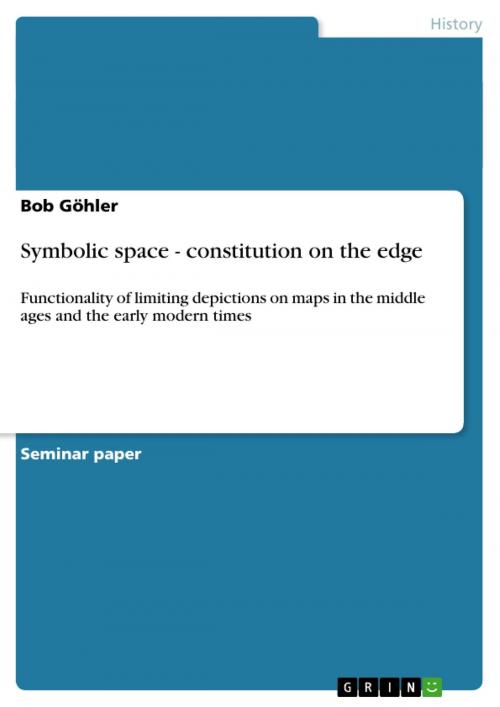Symbolic space - constitution on the edge
Functionality of limiting depictions on maps in the middle ages and the early modern times
Nonfiction, History, European General| Author: | Bob Göhler | ISBN: | 9783640201280 |
| Publisher: | GRIN Publishing | Publication: | November 5, 2008 |
| Imprint: | GRIN Publishing | Language: | English |
| Author: | Bob Göhler |
| ISBN: | 9783640201280 |
| Publisher: | GRIN Publishing |
| Publication: | November 5, 2008 |
| Imprint: | GRIN Publishing |
| Language: | English |
Seminar paper from the year 2008 in the subject History Europe - Other Countries - Middle Ages, Early Modern Age, grade: 2+, Humboldt-University of Berlin (Institut für Geschichtswissenschaft), course: Kultur- und Geistesgeschichte der Bildung europäischer Räume in der frühen Neuzeit, 27 entries in the bibliography, language: English, abstract: Not only since the initiation of cartography-history medieval maps and those of the early modern times impressed but also bothered modern viewers. It is evident that in any map the world is presented as flat. This fact resulted in the assumption, medieval human beeings considered the world as a flat disc. It is remarkable that there seems to be a development of mapping, changing through differing concepts and differing utilization of maps in various fields. This change of different natures of depictions of the world was over years used by generations of scientists to postulate a successive development from somehow religious maps (like the Hereford-map, the Ebstorf-map and other medieval T-O-maps) to those scientific maps like the Waldseemüller-map or other later maps. It is promising to recontextualise the T-O-Maps and understand them as a kind of 'geography of meaning'. Following this approach means taking a closer look at the maps and trying to find out what kind of world is depicted there, what exactly is represented and, in a matter of space perception as this essays questioning demands, what spaces are depicted and how they are delimited. Upon this closer examination a methodological closer consideration of the use of the maps and its rules and conditions is indispensable. Maybe a differentiation between depicted world models, as the considered period covers howbeit the birth of measuring geography, results in a distinction of differing depicted spaces. This way possibly the edge-phenomena variations like monsters, cosmological signs and other symbols taken out of a rich knowledge-reservoir you may find in medieval as well as in early modern mapping, can maybe enlight the idea of the space that they are delimiting. In case of imposing restrictions on the topic, the following thoughts are based on single case studies of maps with differing edge-depicting practice between 1200 and 1760.
Seminar paper from the year 2008 in the subject History Europe - Other Countries - Middle Ages, Early Modern Age, grade: 2+, Humboldt-University of Berlin (Institut für Geschichtswissenschaft), course: Kultur- und Geistesgeschichte der Bildung europäischer Räume in der frühen Neuzeit, 27 entries in the bibliography, language: English, abstract: Not only since the initiation of cartography-history medieval maps and those of the early modern times impressed but also bothered modern viewers. It is evident that in any map the world is presented as flat. This fact resulted in the assumption, medieval human beeings considered the world as a flat disc. It is remarkable that there seems to be a development of mapping, changing through differing concepts and differing utilization of maps in various fields. This change of different natures of depictions of the world was over years used by generations of scientists to postulate a successive development from somehow religious maps (like the Hereford-map, the Ebstorf-map and other medieval T-O-maps) to those scientific maps like the Waldseemüller-map or other later maps. It is promising to recontextualise the T-O-Maps and understand them as a kind of 'geography of meaning'. Following this approach means taking a closer look at the maps and trying to find out what kind of world is depicted there, what exactly is represented and, in a matter of space perception as this essays questioning demands, what spaces are depicted and how they are delimited. Upon this closer examination a methodological closer consideration of the use of the maps and its rules and conditions is indispensable. Maybe a differentiation between depicted world models, as the considered period covers howbeit the birth of measuring geography, results in a distinction of differing depicted spaces. This way possibly the edge-phenomena variations like monsters, cosmological signs and other symbols taken out of a rich knowledge-reservoir you may find in medieval as well as in early modern mapping, can maybe enlight the idea of the space that they are delimiting. In case of imposing restrictions on the topic, the following thoughts are based on single case studies of maps with differing edge-depicting practice between 1200 and 1760.















